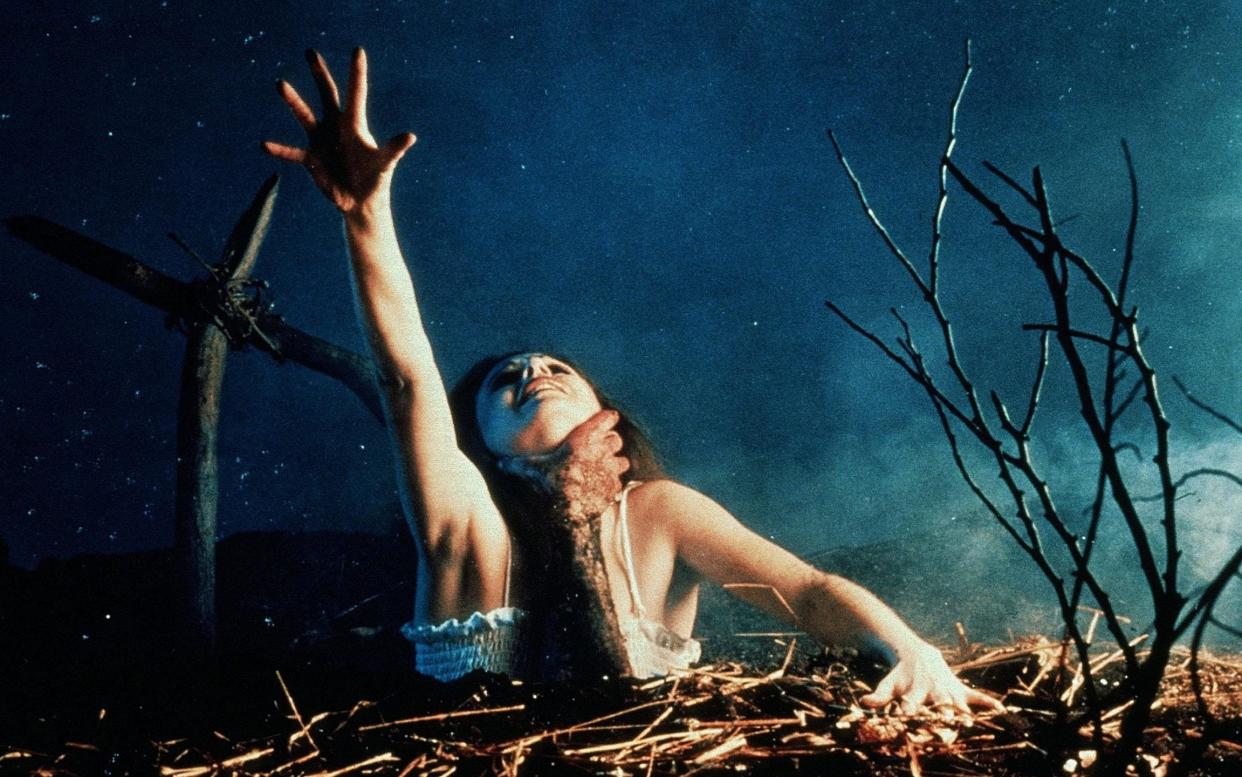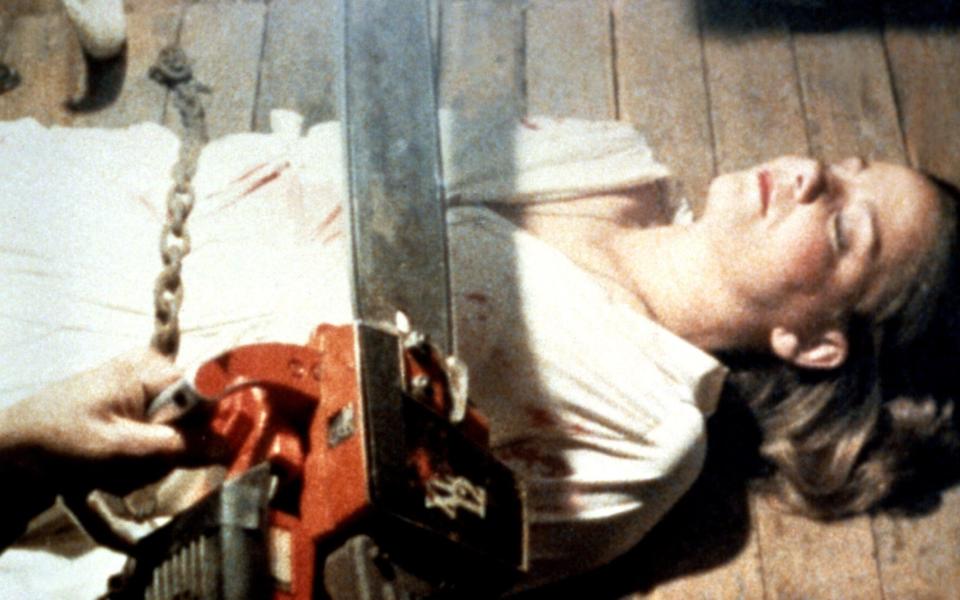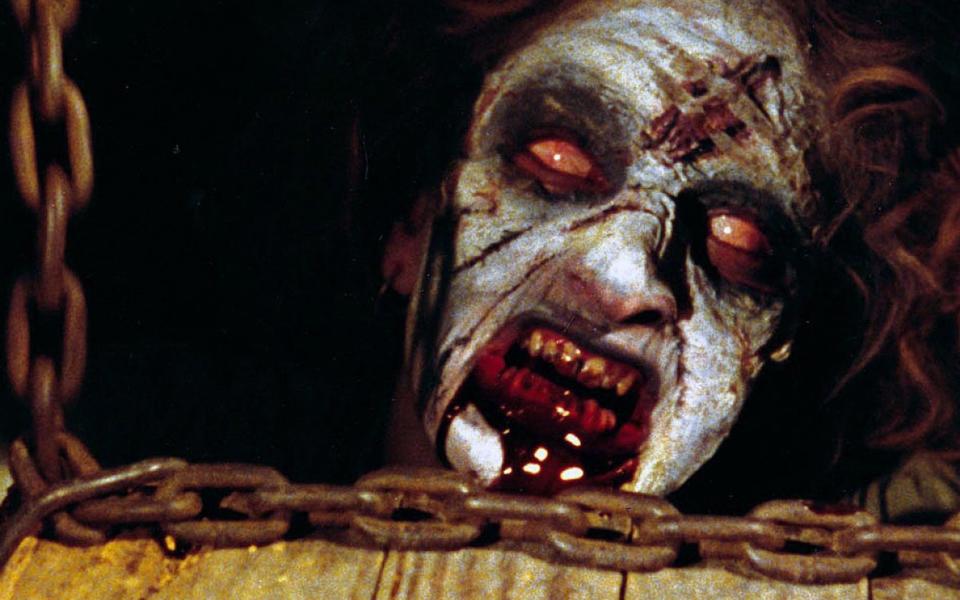The ‘extreme pain and misery’ behind horror classic The Evil Dead

With the continued success of Marvel and other superhero movies, it’s worth remembering that the whole genre owes its renaissance to Sam Raimi. His first Spider-Man film in 2002 took the films away from the listless campery of Joel Schumacher’s Batman pictures and in a thrilling, witty new direction. Since then, he’s had many significant hits, and is currently in post-production on his latest high-profile movie, the Doctor Strange sequel. Not bad going for a man who began his career, 40 years ago, with a low-budget horror that shocked audiences, delighted genre fans and outraged censors.
Today, The Evil Dead is regarded as one of the most significant and influential horrors ever made. It spawned two sequels, a spin-off television series and video games and comic books, as well as turning its star Bruce Campbell into a B-movie icon. This is an impressive achievement given its inauspicious origins, which arose from little more than childhood friends wanting to fulfil their dream of making a film about HP Lovecraft’s creation The Necromicon.
Yet it has continued to arouse controversy, both for its envelope-pushing violence and gore and for a notorious scene of supernatural sexual assault that Raimi himself has publicly regretted. Four decades after its creation, it continues to enthral audiences, despite or because of its low-budget origins.
Watch: Evil Dead officially rising back to screens with new sequel
Raimi, his brother Ted and Campbell all grew up around Michigan. They began making short 8mm films in the Seventies that had names like Pies and Guys and Three Pests In A Mess, all of which owed a heavy debt to the slapstick humour of the Three Stooges. As Raimi became more ambitious, the films became longer and more elaborate; there was a James Bond spoof, James Bombed In Here Today…Gun Tomorrow, and a detective comedy, It’s Murder. Although neither was seen by anyone apart from friends and family – Campbell subsequently dismissed It’s Murder as “a bomb, a total flat-out bomb, a two thousand dollar bomb” – Raimi was by now interested in making horror movies in the vein of the low-budget pictures that he admired at the time, such as The Hills Have Eyes and The Texas Chainsaw Massacre. That these films were hugely profitable was an added incentive.
By 1979, Raimi had written a script that he presented to his friend Rob Tapert, who would act as producer. It borrowed heavily from Lovecraft and other horror films, but had an intriguing twist. The central imperilled character, usually a woman, was written as a man, and Campbell would be cast in the role of Ash Williams, a university student who finds himself in dire peril after he and his friends accidentally release an army of evil spirits. As Campbell later said: “Sam felt that could make it even more horrifying; if you could reduce a man to scrambling and screaming and yelling and being tormented, it would be even more horrifying than a woman doing that…we figured in our own borderline chauvinistic way, that would be worse.”
In order to raise investment and interest, Raimi filmed a preview short picture, Within the Woods. The half-hour horror film was made over six days, featured gory make-up effects and was designed to scare audiences. Raimi later acknowledged that “it was more effective in making the audience scream than Evil Dead was, so in that way it was better. But it wasn’t as professionally photographed…[it provided] more of an experience like John Carpenter did with Halloween.”
It was screened at a local cinema as a double-feature with the perennially popular Rocky Horror Picture Show, and elicited some mild interest. An emboldened Rami now decided to make his debut proper with his script, entitled Book of the Dead, and he raised a total of $375,000 from investors, all of whom he wooed by describing the cost-to-profit ration that many successful horror films had enjoyed. Campbell had already been cast in the lead, but finding other actors for the low-budget picture was difficult. As Campbell later said: “When any girls auditioned, their boyfriends came with them because it sounded more like a porno film.”
Eventually, Raimi, Campbell, Tapert and their cast headed to Tennessee in late 1979, where the film would be shot in a remote cabin. This down-at-heel shack would also serve as lodgings for the 13-person strong crew, and was far from an ideal place to stay. Not only had it been overrun by cows and was covered in manure, but it also had a reputation for being haunted. Campbell commented: “We worked out a deal with the owners that we would leave it no worse than we found it, which even if we destroyed the place would have been no real change.”
When filming began in November 1979, the hitherto amicable Raimi began displaying auteur-ish tendencies. Campbell would later call the protracted filming process “12 weeks of mirthless exercise in agony”, and the unrepentant director argued that in order to make the ghastliness depicted on screen feel at all authentic, he had to put his cast through a form of torture. As he said: “If everyone was in extreme pain and misery, that would translate into a horror.” This included his prodding Campbell with a sharp stick when he felt that his leading man was being insufficiently fearful.

Yet Raimi did not spare himself, later saying: “I’ve never worked so hard or so long in my life.” In addition to directing, he had to serve as cameraman, screenwriter, make-up artist and assistant director, and often found himself attempting to operate the camera covered in the dyed corn syrup that the film used for the (extensive) amounts of fake blood that it required. Occasionally, drunken locals would come by to enquire what was going on in the abandoned cabin, and, upon learning that a movie was being made, would demand to be cast in it. They were humoured, as otherwise there was the possibility that, disgruntled, they might have damaged the cabin; there was no additional budget to rebuild the set.
One technical innovation of Raimi’s, which he would return to throughout his career, was a first-person technique known as the “shaky cam”, which he used to provide the perspective of the supernatural beings tormenting the cast. The Steadicam, which provided long, smooth shots, had recently been invented (and would be popularised by Stanley Kubrick in The Shining) but there was no budget to hire such sophisticated equipment, so Raimi improvised by tying the camera to bicycles and pieces of wood and having its operators run as fast as they could around the cabin. It proved hugely effective, and became one of the director’s signature trademarks.
Filming was completed at the end of January 1980, and the exhausted, at times rebellious, cast and crew disbanded. Raimi believed that the film needed more special effects and spectacular scenes of gore to act as a climax, and so improvised some grotesque moments of horror, involving bodies decomposing and eyeballs exploding. This was achieved by a mixture of stop-motion, animation and unorthodox make-up effects; the primary gore was constructed from a combination of peanut butter and chocolate. After a lengthy post-production process, which involved none other than Joel Coen as assistant editor, the film was eventually premiered to an audience of investors and friends on 15 October 1981, who sat through it in numb horror. This, a delighted Raimi believed, was exactly the reaction that he had been hoping for. Tapert said: “Afterwards, [the audience] were all charged up, as it was so visceral.”
The scene that had attracted the most controversy, and would continue to do so, was when the female lead Cheryl Williams, as played by Ellen Sandweiss, was raped by a tree. Sandweiss found the filming a miserable and degrading experience, saying: “I scraped the hell out of myself…there was a lot of pain involved with that movie”; although she acknowledged that, “I was twenty years old, and it was very exciting, and I was with friends.”
She reserved particular distaste for the assault scene, and said: “I guess I didn’t really realise what that was going to look like on the big screen; that’s actually the reason I don’t want my kids to see it.” Although she would later work with Raimi again, and eventually reprised the role of Cheryl in the Ash vs Evil Dead television series, Williams abandoned the acting profession for decades afterwards, although she claimed that this was unrelated to her traumatic experiences on set.

As a result of the film’s extreme horror and gore, no mainstream distributor wanted to be involved with it, until the veteran producer and impresario Irvin Shapiro took an interest in it. Shapiro had introduced American audiences to films such as Jean Renoir’s La Grand Illusion and Jean-Luc Godard’s Breathless, but had a keen eye for highbrow and low-brow cinema alike. When he walked out of a screening, he said to Raimi, Campbell and Tapert: “It’s your lucky day, boys. It’s not Gone With The Wind, but I think I can make you some money.” He suggested, however, that the title be changed. After coming up with, and rejecting, the likes of Blood Flood and These Bitches Are Witches Companion, the name The Evil Dead was proposed, and stuck.
Shapiro suggested that the film be taken to European film festivals, where it garnered acclaim. It was a hit at the Cannes Film Festival, where the author Stephen King was especially impressed by it. Not only did he say of it that “it was like a thunderstorm in a bottle, just relentless”, but he wrote a contemporary review in which he called it “the most ferociously original horror film” and “a black rainbow of horror…you want to leap up, cheering.”
It now began a staggered release across the world, with King’s all-important endorsement opening the door to lucrative midnight shows in Britain. Unfortunately, its UK distributor Palace Pictures was accused of promoting an “obscenely bloody” film and Palace’s head Nik Powell was arrested for violation of the Obscene Publications Act, even though it had received a BBFC certificate after 49 seconds of cuts had been made. Although Raimi was on hand to be called as a witness if required, the case was dropped, with the judge saying: “Such frivolous prosecutions bring the administration into disrepute. In my judgement, these proceedings ought not to have been started.” It received an X rating in America, by then a classification associated with pornography, so it was released unrated to terrified and impressed audiences.

Eventually, many years after its release, it turned a profit. But the critical acclaim with which it had been greeted – Variety called it “the ne plus ultra of low-budget gore and shock effects” – saw Raimi begin a mainstream directorial career, although he would return to the Evil Dead universe twice cinematically, with Evil Dead 2: Dead by Dawn and Army of Darkness: The Medieval Dead. Campbell became a cult icon and has gamely reprised his role of Ash countless times across various media, in increasingly self-parodying fashions. The cabin where the original film was made was, inevitably, burnt down in 1982 by drunken locals, keen to see where the horror had been created. And The Evil Dead became regarded as a cult classic, talked of in awestruck terms.
Yet changing times meant that it continued to be treated with suspicion by censors. After its initial UK release, it was refused a video certificate, and was lumped in with the “video nasties” that Mary Whitehouse so vociferously campaigned against. It was not considered suitable for a home video release until 1990, and was heavily cut, with most of the edits now coming in the tree rape scene. It was not released in its full unexpurgated version in 2001, with the BBFC agreeing that what had once seemed unpalatable now seemed more acceptable.
Yet controversy about the sexual assault sequence has continued to dog the film. Raimi, by now a major Hollywood director, acknowledged this in a 2012 interview when he said that he regretted its inclusion and that: “I think it was unnecessarily gratuitous and a little too brutal. And finally because people were offended...my goal is not to offend people. It is to entertain, thrill, scare...make them laugh but not to offend them.”
Raimi finally accepted that his judgement “at the time” was askew. This might have been communicated to the makers of the 2013 remake of the film, which included Raimi and Tapert themselves. As the remake’s director Fede Alverez said, the producer asked, explicitly: “Where’s my raping tree?” Its inclusion, albeit considerably toned down and less explicit, led to a second round of controversy and outrage. This seems the quintessence of The Evil Dead. Even 40 years on, its DIY legacy of homemade horror still appalls audiences, but its innovation and daring is what it should be celebrated for, not the tasteless inclusion of demonically possessed woodland.
Watch: Five of the best ever prosthetic movie makeups


